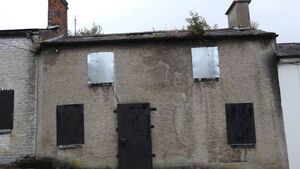It's time to tackle the scourge of dereliction

Derelict properties represent a terrible eyesore in their community, and there are dangers attached too.
We are in a housing crisis in Ireland. It is more prevalent in the east coast than in the west yet there are plenty of pinch points here too where demand outstrips supply.
Yet, conversely, in virtually every town and village in the country we have the scourge of derelict houses, once cherished homes, let go and allowed to decay over years and decades.
There are a total of 160,000 vacant homes in this country. In Mayo, according to the 2022 Census, there are 8,922 vacant homes (not including holiday homes). Most are not legally derelict, of which more anon, but that is a staggering number of houses lying idle in this county.
There are often heated debates about one-off rural housing, and whatever the pros and cons of that, there can be no doubt how under-utilised so many vacant and derelict homes are.
To say something needs to be done about the amount of vacant and derelict homes is putting it mildly. Many of them represent a terrible eyesore in their community, and there are dangers attached too. Unsecured buildings can become a hunting ground for children looking to explore. They are not safe to be in with internal roofs often crumbling yet are often all too accessible.
And recent storms have highlighted the dangers of loose tiles from their roofs which can and have caused significant damage to other homes and represent a danger of serious injury to people.
It is sad to see once-vibrant homes, full of memories and often big, local personalities, decaying and disintegrating. Little mementos of their past are evident when you look in the windows and see picture frames from a generation ago, a saucepan on a hob, delph and furniture just left there as if someone walked out the door one day and never came back.
There can be many reasons why houses fall into dereliction. It might be owned by someone abroad who has intentions of doing something with it but has put it on the long finger; there may be complex family arrangements as to ownership or ownership might be in dispute; the owner may not have the funds to restore the property.
It is doubtful anyone sets off with the intention of their site becoming derelict, but without enough censure and penalties, it can easily slip down the list of someone’s priorities.
Also, though, allowing that to happen demonstrates a massive lack of civic pride, a massive lack of responsibility to the community where that house is.
People living in that community have to live beside a home that is crumbling; people have to drive past it and, unfortunately, when dereliction is seemed to be tolerable, it happens more frequently. So much so that many civic-minded community groups have taken it upon themselves to paint and enliven many derelict buildings, giving them a fresh look and a reminder of what can easily be done. But that should not have to happen.
From a state point of view, what is being done about dereliction and what more can be done?
There is a difference between a vacant home and a derelict one, both legally and objectively. A derelict home is not just a vacant home, but one which has become structurally unsound. Legally, a building is not considered derelict unless it has been registered by the local council – Mayo County Council in our case – on their Register of Derelict Sites under the Derelict Sites Act (1990).
The Act defines a derelict site as any land that "detracts, or is likely to detract, to a material degree from the amenity, character or appearance of land in the neighbourhood of the land in question because of: Structures which are in a ruinous, derelict or dangerous condition; the neglected, unsightly or objectionable condition of the land or of structures on it, or the presence, deposit or collection of litter, rubbish, debris or waste".
According to data given in December 2024 at a meeting of Mayo County Council’s Environment and Climate Change Strategic Policy Committee (SPC), there are 252 sites on the Register in Mayo. Not all are homes – some are commercial buildings. A cursory look at the register will confirm it only scratches the surface. There are far more derelict sites in Achill, where I live, than appear on the Register.
There are funding supports available for owners of vacant and derelict properties. The Croí Cónaithe Vacant Property Refurbishment Grant offers €50,000 for refurbishing a vacant property and an additional €20,000 on top of that for properties deemed derelict.
As of the end of January 2025, a total of 478 grants had already been approved in Mayo. It shows very good levels of interest and engagement in the scheme. It rewards those seeking to be proactive but there is still nowhere near enough of a deterrent in place for those who continue to sit on their hands while the properties they own continue to be a blight in communities.
There is a sanction. Sites on the Register of Derelict Sites – recall it is far from a complete list in this county – may be subject to a levy of 7% of the market value of the property.
The key word there is ‘may’ – there is no guaranteed sanction. And you only need to worry about any such sanction once you are put on the Register.
Mayo County Council’s Director of Services for Housing, Tom Gilligan, has been very proactive on the issue of vacancy but enforcement, generally, on such matters is slow. County councils are massively under-resourced in Ireland and so the resources they may need are not always there.
The majority of local authorities in Ireland did not collect any dereliction levies in 2022. Mayo was not among them but it highlights the lack of enforcement and, therefore, those not civic-minded or proactive have little in the way of deterrent or motivation.
But with the right lead from central government and a radical approach to tackling the issue, there can be dramatic change.
At a meeting of Mayo County Council’s Housing SPC in February, Cllr Harry Barrett (Ind) put forward a series of proposals on dereliction. In doing so, he was echoing the observations and ideas of economist David McWilliams in a recent column.
McWilliams suggested a tax amnesty for owners of derelict buildings, that they could avoid capital gains tax if they sell within a set period (suggesting 18 months).
“Amnesties work. They give people an exit strategy. As the old saying goes, you catch more flies with honey than vinegar,” said McWilliams.
Once that tax amnesty period is over, McWilliams proposes the State should "impose a crushing dereliction levy" which, if left unpaid in a short period, will lead to the property being compulsorily purchased by the local authority for a fraction of its value.
Of course, not every derelict property will sell in the tax amnesty period. Incentivising the renovation of derelict properties ought to help increase demand for such properties and perhaps a safety net of the local authority buying the property for a set percentage of its market value (say 75%) and then renovating for social housing can give owners a way out if they cannot find a buyer before hitting punitive levies.
Incentivising the purchase and renovation of derelict and vacant properties is part of the symbiotic dynamic McWilliams proposes.
“The second part of the process is to make it profitable to buy, renovate and redevelop derelict buildings and sites," he argued. "It should also be made profitable for owner/occupiers to move into these buildings... A 100% tax deductibility allowance could be introduced, so that the cost of purchasing could be set off against taxes over a set period. To accelerate development there could be a time-sensitive kicker, so that if building starts immediately the allowance is 100% and this begins to fall as each year passes … In addition, the cost of materials could also be tax deductible. The incentive has to be so enormous as to make it a no-brainer."
Where there is a will, there is a way. Expecting owners of derelict properties to take the lead is naïve. Communities throughout Mayo and the country deserve better. Incentivising the sale and the purchase of derelict properties can rejuvenate communities and bring life, love and laughter back to idle homes. Why not be radical?






